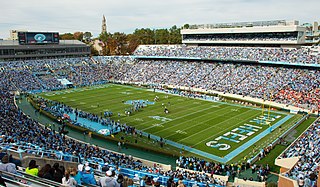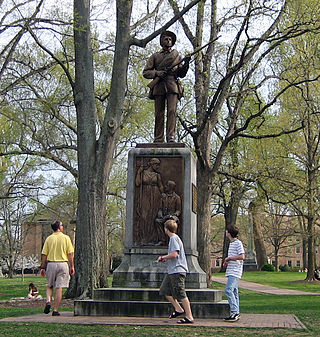
Chapel Hill is a town in Orange and Durham counties in the U.S. state of North Carolina. Its population was 61,960 in the 2020 census, making Chapel Hill the 17th-largest municipality in the state. Chapel Hill, Durham, and the state capital, Raleigh, make up the corners of the Research Triangle, with a total population of 2,106,463 in 2020 census.

The University of North Carolina at Chapel Hill is a public research university in Chapel Hill, North Carolina. It is the flagship of the University of North Carolina system and is considered to be one of the "Public Ivies". After being chartered in 1789, subsequent to the first land-grant university, the University of Georgia, the university first began enrolling students in 1795, making it one of the oldest public universities in the United States. Among the claimants, the University of North Carolina at Chapel Hill is the only one to have held classes and graduated students as a public university in the eighteenth century.

Kenan Memorial Stadium is a stadium located in Chapel Hill, North Carolina and is the home field of the North Carolina Tar Heels. It is primarily used for football. The stadium opened in 1927 and holds 50,500 people. It is located near the center of campus at the University of North Carolina.

The Confederate Monument, University of North Carolina, commonly known as Silent Sam, is a bronze statue of a Confederate soldier by Canadian sculptor John A. Wilson, which once stood on McCorkle Place of the University of North Carolina at Chapel Hill (UNC) from 1913 until it was pulled down by protestors on August 20, 2018. Its former location has been described as "the front door" of the university and "a position of honor".

William Donald Carmichael, Jr. Arena is a multi-purpose arena on the campus of the University of North Carolina at Chapel Hill in Chapel Hill, North Carolina, United States. It is home to four Tar Heels athletic teams: women's basketball, volleyball, women's gymnastics, and wrestling. It is named for William Donald Carmichael, Jr., a popular former school vice-president and brother of All-America basketball player Cartwright Carmichael.

The Nuclear Waste Policy Act of 1982 is a United States federal law which established a comprehensive national program for the safe, permanent disposal of highly radioactive wastes.

Lake Karachay, sometimes spelled Karachai or Karachaj, was a small lake in the southern Ural mountains in central Russia. Starting in 1951, the Soviet Union used Karachay as a dumping site for radioactive waste from Mayak, the nearby nuclear waste storage and reprocessing facility, located near the town of Ozyorsk. Today the lake is completely infilled, acting as "a near-surface permanent and dry nuclear waste storage facility."

The New Safe Confinement is a structure put in place in 2016 to confine the remains of the number 4 reactor unit at the Chernobyl Nuclear Power Plant, in Ukraine, which was destroyed during the Chernobyl disaster in 1986. The structure also encloses the temporary Shelter Structure (sarcophagus) that was built around the reactor immediately after the disaster. The New Safe Confinement is designed to prevent the release of radioactive contaminants, protect the reactor from external influence, facilitate the disassembly and decommissioning of the reactor, and prevent water intrusion.

Nuclear decommissioning is the process leading to the irreversible complete or partial closure of a nuclear facility, usually a nuclear reactor, with the ultimate aim at termination of the operating licence. The process usually runs according to a decommissioning plan, including the whole or partial dismantling and decontamination of the facility, ideally resulting in restoration of the environment up to greenfield status. The decommissioning plan is fulfilled when the approved end state of the facility has been reached.

Franklin Street is a prominent thoroughfare in Chapel Hill, North Carolina. Historic Franklin Street is considered the center of social life for the University of North Carolina at Chapel Hill, as well as the town of Chapel Hill.

The Charles T. Woollen Gymnasium was the home of North Carolina Tar Heels men's basketball team from January 2, 1939, through February 27, 1965, across twenty-six seasons. Due to increased demand for viewing the varsity basketball team and limited capacity at then home court the Tin Can, school president Frank Porter Graham and Charles T. Woollen requested public funds for a new gymnasium and women's dormitory. After being rejected at the federal level, the North Carolina Public Works would award a grant of $283,090 to build a new gymnasium and the school would have to fundraise to cover the cost's remainder. The plans for the building included multi–level building that included an attached swimming pool, along with a main lobby that would overlook the main gymnasium area. Aside from varsity basketball, the building was used for physical education classes, recreational activity for students, and office spaces. Construction stretched from 1937 to 1938 and, upon completion, was seen as "modern" and one of the highest–quality basketball facilities in the Atlantic Coast Conference.

Mount Parish is a hill in Wan Chai, Hong Kong, to the south of Queen's Road East, between Kennedy Road and Stubbs Road.

The North Carolina Tar Heels field hockey team represent the University of North Carolina at Chapel Hill in the Atlantic Coast Conference of NCAA Division I field hockey.

Horace Williams Airport was a public use airport located one nautical mile north of the central business district of Chapel Hill, a city in Orange County, North Carolina, United States. It is owned by the University of North Carolina at Chapel Hill. Although most U.S. airports use the same three-letter location identifier for the FAA and IATA, this airport is assigned IGX by the FAA but has no designation from the IATA.

High-level radioactive waste management concerns how radioactive materials created during production of nuclear power and nuclear weapons are dealt with. Radioactive waste contains a mixture of short-lived and long-lived nuclides, as well as non-radioactive nuclides. There was reportedly some 47,000 tonnes of high-level nuclear waste stored in the United States in 2002.

The William and Ida Friday Center for Continuing Education is a unit of the University of North Carolina at Chapel Hill. The center was created to serve the needs of nontraditional students through continuing education programs and services.

Over 8,000 undergraduate and graduate students live in campus housing at the University of North Carolina at Chapel Hill during a regular school year. Forty residence halls are grouped into 16 residential communities across campus.

The Louis Round Wilson Library is a library at the University of North Carolina at Chapel Hill. Completed in 1929, it served as the university's main library until 1984. Today, it houses several special collections. The dome rises 85 feet over the university's South Quadrangle.

The UNC Coastal Studies Institute is a campus used for research of the coastal environments and eco-systems, at 850 NC-345, Wanchese, in the Outer Banks of North Carolina, United States. The campus serves East Carolina University, UNC Chapel Hill, North Carolina State University, UNC Wilmington and Elizabeth City State University.





















